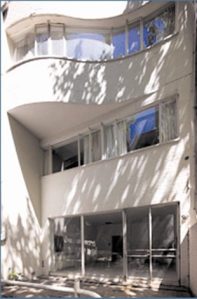
Even if you’re not a fan of modern architecture, the airiness of the space will convert you,” broker Paul Tabor said of the William Lescaze-designed 32 East 74th Street, recently relaunched on the market for $14 million by Brown Harris Stevens‘ Paula Del Nunzio.
Mr. Tabor, a broker at Key Ventures who is not connected with the listing, waxed poetic on the “living kaleidoscope” created by the glass-brick wall on the upper floor. In the mid-20th century, Lescaze was the first to introduce glass bricks into U.S. architecture when he built his own townhouse on East 48th Street.
“It just receives an amazing amount of light; there are 20-foot horizontal windows, and the glass-brick wall gives this beautiful diffusion of light,” Ms. Del Nunzio said.
The back of the house undulates like a Gaudi-sculpted tsunami, offering a cantilevered balcony overlooking the back garden. The Swiss Lescaze was a pioneer of the “International Style” more widely associated with household names Mies van der Rohe and Le Corbusier. The 1935 house retains much of his original interior detailing, such as the millwork and the built-in storage.
But is the property, which sticks out like a sore thumb on a townhouse block of Beaux-Arts beauties and bow-front brownstones, only valuable as an architectural relic, or could a townhouse-hunting family plop down their carpetbags and call it home? “Optimally, it would be an extraordinary place for a person with a wonderful Modern Art collection,” Mr. Tabor said. “The first floor opening onto the patio is perfect for a sculpture gallery.”
Warburg’s Richard Steinberg has sold the house twice. “First, I sold it to a young hedge fund couple and then to a single woman. People don’t realize how much work is involved when they buy it; and then they don’t want to do the construction and renovations that are really needed.”
Mr. Tabor disagrees. “It just needs to be lovingly brought back into pristine condition. But nonetheless, even not in pristine condition, just to live in that space would be worth it.”
cmalle@observer.com


